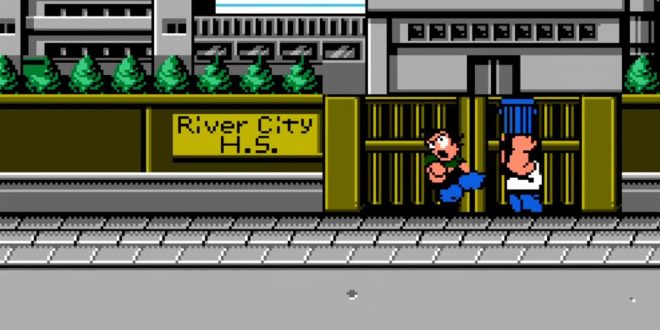However, River City Ransom’s level design was actually closer to a modern Soulsborne title in ways that might help explain why it was so alienating. Beyond the “Where am I supposed to go?” confusion that the game’s layout generated, River City Ransom had a bad habit of implementing severe difficulty spikes in seemingly random ways. The most logical path forward may be filled with enemies that you are not yet capable of defeating. Those who weren’t turned off by the thrill of being immediately destroyed through no apparent fault of their own were forced to grind through “lesser” areas to progress. In that sense, River City Ransom is actually a bit more linear than it may initially appear to be.
Even if that process sounds closer to a nightmare than an innovation, the fact that River City Ransom forced you to “grind” at all reveals the significance of its most influential idea: its use of traditional RPG mechanics.
Defeating enemies in River City Ransom would often reward you with coins that could be used to purchase entirely new combat techniques, better equipment, or upgrades to one of your 10 primary character stats. Said stats determined everything from the base power of your punches and kicks to your ability to avoid being knocked down. Though your reaction times and ability to recognize enemy attack patterns mattered as much in River City Ransom’s combat as those factors did in games like Double Dragon (if not more), River City Ransom was designed to make you feel like all of those otherwise seemingly simple encounters were gradually contributing to something greater.
It was a seemingly simple twist that felt positively inspired in its day. While some early pseudo-ARPGs experimented with a combination of real-time combat and character upgrades (such as Hydlide, Gauntlet, and The Legend of Zelda), River City Ransom was something else entirely. It was, by just about any definition, fundamentally an action game. For that matter, it was a beat-em-up game: the most action-heavy of the action genres available at that time. Yet, River City Ransom added genuine depth to its action by incorporating a surprisingly robust character-building system previously only seen in what were considered to be niche and fairly “hardcore” genre titles.
While River City Ransom certainly had its flaws, it’s hard not to wonder why more action titles didn’t follow in its footsteps in the years immediately following its release. Many of the most notable beat-em-up games of the early ’90s (particularly Konami’s beloved licensed arcade titles) didn’t utilize their own versions of similar RPG mechanics. That combination of real-time combat and character growth was still largely limited to a new generation of ARPGs. Games like Super Adventure Island II and Demon’s Crest certainly feel a bit closer to River City Ransom, but for quite some time, gamers didn’t necessarily expect to encounter traditional role-playing mechanics in their action games.
The situation now is quite different. In the last 20 years or so, we’ve seen a sometimes shocking influx of action games with RPG-like character-building systems. Ignoring obvious River City Ransom successors like Scott Pilgrim vs. the World and River City Girls, we find aspects of River City Ransom’s core design concept in nearly every major modern action title. From Call of Duty and God of War to Hi-Fi Rush and Yakuza, more and more games that rely on real-time action combat also feature systems that require you to upgrade your character along the way. If anything, it’s jarring to play a modern action title that doesn’t offer some version of that idea.
#celeb #celebrity
